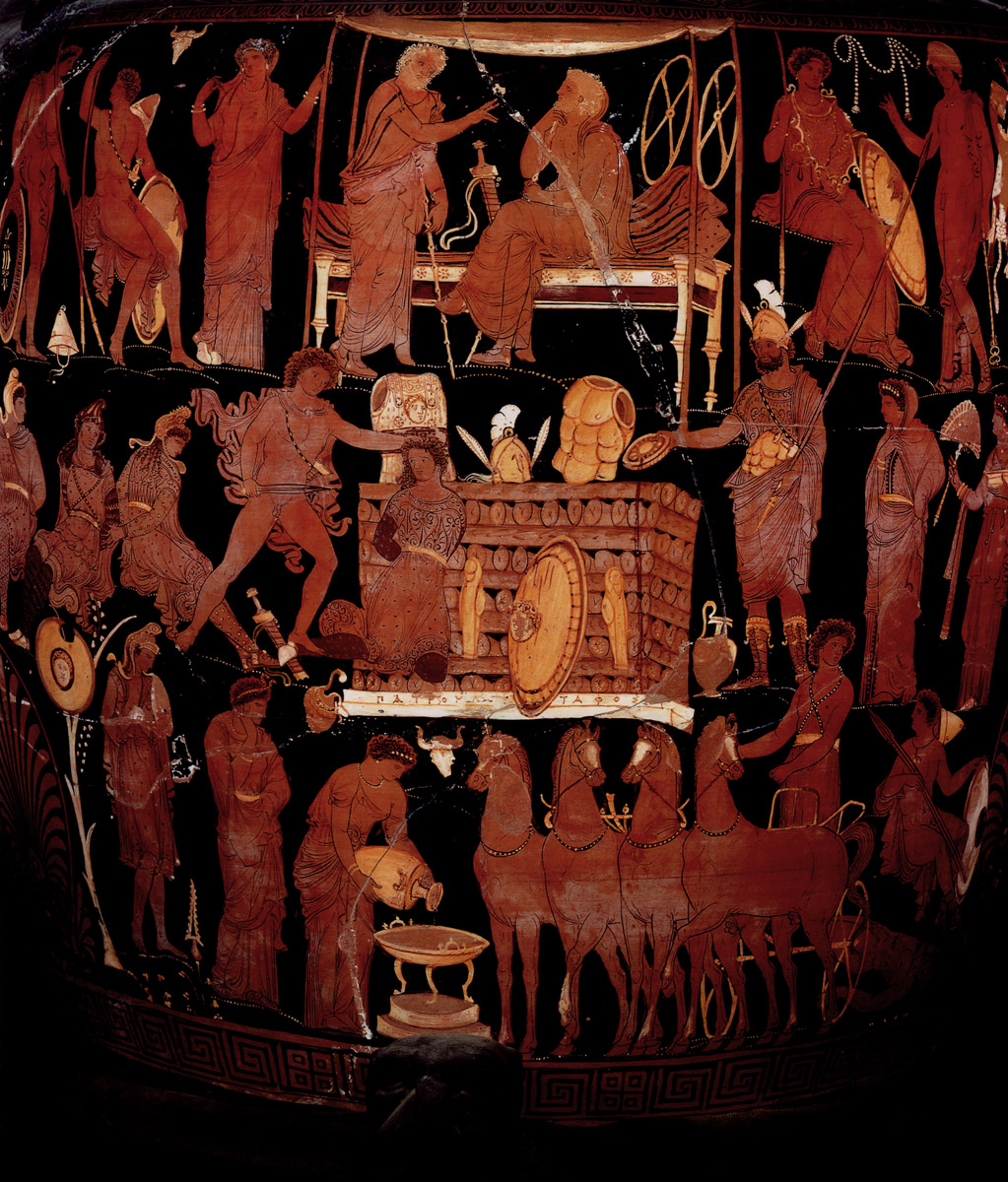
Darius Painter.
Clay. 340—320 BCE. Inv. No. 81954 (?).Naples, National Archaeological Museum
So-called “Vase of Patroclus”, side A.
Darius Painter.
Clay. 340—320 BCE.
Naples, National Archaeological Museum
(Napoli, Museo archeologico nazionale).
On the neck, side A: Oedipus, naked, with chlamys, club and quiver, and the Sphinx in the presence of a Fury, surrounded by plant volutes and flowers; side B: Dionysius, with garland and thyrsus, Arianna with patera and headbands, Silenus seated with kantharos and thyrsus, a group formed of Maenad with thyrsus hanging from a headband and Silenus with patera and laurel branch; on the shoulder, palmettes alternating with lotus flowers and an ovoid motif; around the grotesque masks of the handles, there are spirals, plant volutes, rosettes and bell-shaped flowers; beneath the handles, there are palmettes, plant volutes and leaves; on the body, beneath the figurative scenes, there is a meandering motif and on the base, sprays of ivy.
On the body the figurative scene is structured into three overlapping registers.
Side A: in the upper register, the cloaked figures of Nestor and Phoenix, with long sticks, in discussion on a kline (couch) under an awning; on the left, there are two warriors and a female figure (Briseis?) leaning on the awning, on the right Athena, Hermes and Pan.
In the second register: in the centre, there is the funeral pyre of Patroclus with the hero’s weapons, on the left, Achilles in the act of sacrificing a Trojan, followed by three other seated prisoners with their hands bound awaiting the same fate; on the right, Agamemnon, in the act of carrying out a ritual libation, a female figure (Thesis or Clytemnestra) with a diadem on her head, followed by a handmaiden with a fan and patera.
In the lower register: Automedon on a war chariot while dragging the lifeless body of Hector, preceded by two women in the act of pouring water in preparation for the cleansing of the dead hero, followed by another Trojan prisoner.
Side B: farewell scene on three registers with a small funeral temple in the centre, from the ceiling of which a helmet, a shield and two chariot wheels are hanging. Inside there is a naked warrior conversing with a seated female figure, accompanied by a servant. On the sides of the building there are eight figures arranged on two levels: a young man seated with a wreath and headband, and a female figure offering gifts with a box and ribbon; a young man in the act of offering an amphora to a female figure seated on the pedestal of the temple; a naked young man, seated, with a club and patera and standing female figure with a wreath and fan; a woman seated with a casket and musical instrument and the standing figure of a naked young man, with chlamys and ribbon. Finally, in the lower register, there are five nude warriors, with spears, helmets and shields.
Accessory decoration: on the lip, ovolo pattern; on the neck, from the top downwards, berries and laurel leaf shoots interspersed with bell-shaped flowers converging towards a rosette, wavy motif, palmettes paired on side A, ivy shoots and corymbs on side B.
In the krater, in which the main theme is therefore the funeral of Patroclus, the anti-Persian propaganda is quite clearly indicated by the association of the Persians with the Trojans, who were defeated by the Greeks. The tripartite pattern, with a narrative divided into several episodes beginning from the bottom upwards, adopted by the Darius Painter to whom the vase is attributed, recalls the compositional models of the famous Greek painter Apelles.
© 2006. Ministero per i Beni e le Attività Culturali.
© 2006. Mondadori Electa S.p.A., Milano.
© Photo: Scala Group, Firenze.
© 2017. Description: http://cir.campania.beniculturali.it